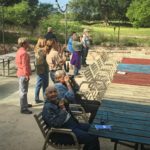Recent workshop at Fort Clark Springs highlighted birding, ecotourism
Contacts: Dr. Maureen Frank, 830-278-9151, [email protected]
Emily Grant, 830-563-2442, [email protected]
BRACKETTVILLE – A group of nature enthusiasts participated in and learned about birding as an aspect of Texas ecotourism at the recent two-day Fort Clark Springs Birding Workshop presented by the Texas A&M AgriLife Extension Service and Fort Clark Springs.
Participants from throughout South Central Texas received instruction on the basics of birding and binocular use, bird identification and managing property for attracting birds.
“We chose Fort Clark Springs for the workshop site because it’s a great natural area as well as an area of historical significance to the state,” said Emily Grant, AgriLife Extension agent for agriculture and natural resources, Kinney County. “The area also has a terrific diversity of wildlife, including birds.”
Grant said on the first day of the workshop attendees learned about birding and enjoyed a beautiful day on the site’s nature trails. On the second day, they participated in an early morning walk and birding expedition at Las Moras Creek.

Kathy Bader of Brackettville, a third-generation birder, was among the workshop participants.
“The presentations and demonstrations were excellent and everyone enjoyed the workshop and the birding walk,” she said. “We went through the process of how to look for birds and for specific characteristics of the birds, then got practical experience with the birding.”
Bader said as a local birder she was glad Fort Clark Springs was selected as the site for the workshop.
“I appreciated the fact that people got to see what a great location this is for birding,” she said. “I bird with my friends and we enjoy the area. Birding is fun at any age, but I hope we can get more young people interested since that will help us preserve important natural areas like this.”
Carol Ann Goodwin, events coordinator at Fort Clark Springs, said the site has a rich and varied history.
“We’re on the site of a historical fort on what was the Pecos Trail, and we’re a bird sanctuary,” Goodwin said. “There are about 50 bird species we see on a regular basis, many of which can be found near the creek area.”
She said some of the birds commonly seen at Fort Clark Springs include the great horned owl, several types of kingfishers, bluebirds, woodpeckers, flycatchers and robins, as well as painted buntings, red-naped sapsucker, cedar waxwings, American coots, black phoebes, red-shouldered hawks, eared grebes, and ruddy and mallard ducks.
“Birding is a growing area for ecotourism in Texas,” said Dr. Maureen Frank, AgriLife Extension wildlife specialist, Uvalde. “Texas is close enough to Mexico and also in the path of a lot of migratory birds, so you have an amazing diversity. You can see birds you’d otherwise need a passport to get near.”
Frank said some of the early season migratory species the workshop group encountered included summer tanagers, yellow-breasted chats and hooded orioles. They also spotted a Couch’s kingbird, which is a migratory species but can be found in the Brackettville area year-round, and saw some common resident species such as black-bellied whistling ducks.
“One of the goals of the workshop was just to get the participants comfortable with using their binoculars and field guide and with spotting and identifying the birds,” Frank said. “The great thing about birding as an ecotourism activity is its accessibility. You can travel to other locations to participate or do it while hiking, or you can stay in a single spot, even do it from a wheelchair. And it doesn’t require a lot of equipment.”


